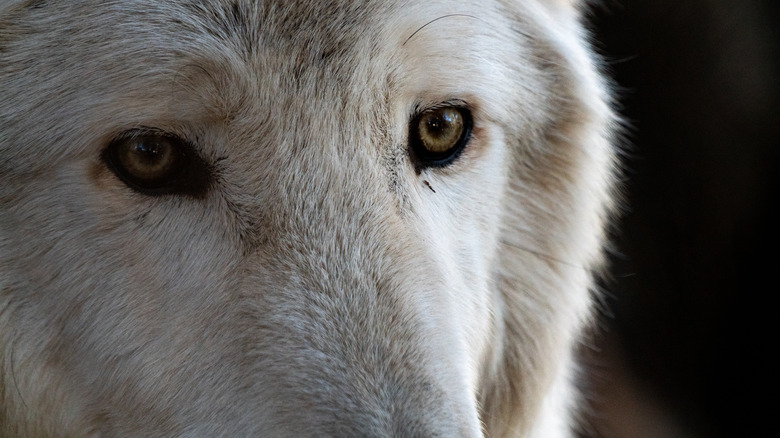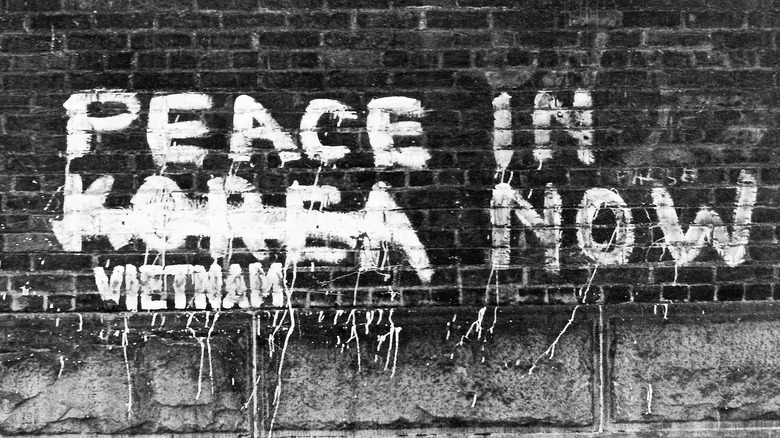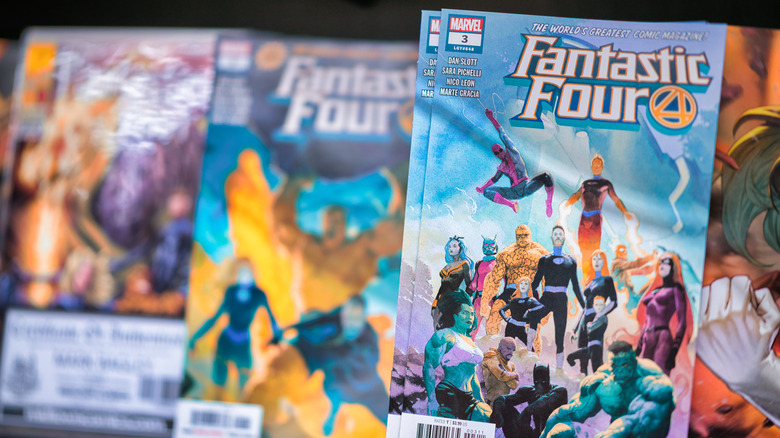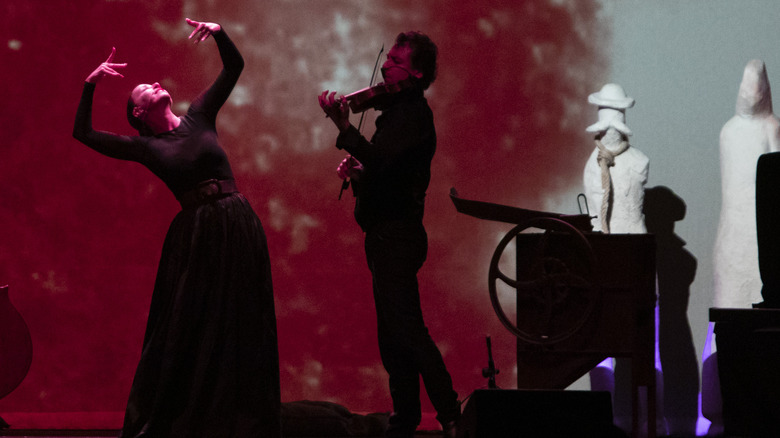Things You Didn't Know About George R.R. Martin
Despite "Game of Thrones" having ended three years ago, the popularity of Westeros, the fictional, blood-drenched fantasy world where the series, and the books that inspired it, are set, is as popular as ever. The recent launch of the spinoff series "House of the Dragon" demonstrates that for George R.R. Martin — the prolific author whose mind spawned Westeros and its many, often unfortunate, inhabitants — this part of his career is far from over.
Martin's upbringing and personal life have been discussed and debated almost as much as the various plot twists in his on- and off-screen fiction. Although he's open about his passions and interests, his various quirks have either been playfully embraced or fiercely criticized. As highlighted by The Independent, his fans remain loyal, despite his sometimes tense relationship with them. Yet Martin remains an enigma, and stubbornly independent in the face of the devotion and disdain that his works have inspired. Some of his more intriguing facets, and perhaps things you didn't know about George R.R. Martin, are detailed below.
He raises money for mistreated wolves
The direwolves, the fictional mammals kept as pets by the Stark children, are a recurring presence in the early seasons of "Game of Thrones." They became such a fan favorite that when Sansa Stark's pet wolf Lady is killed after an altercation between the Stark and Lannister children, fans were openly mourning her death (she was actually adopted by the actor who played Sansa, Sophie Turner).
George R.R. Martin responded through a blog post, gently reminding people that Lady was not real, but that there were plenty of real wolves in existence that had suffered, and still are. He highlighted his support for the Wild Spirit Wolf Sanctuary, a nonprofit based near his home in Santa Fe, New Mexico. Wild Spirit adopts abused and abandoned wolves and wolf-hybrids and raises awareness of the wolf-trafficking trade.
"If you love wolves, and were upset at Lady's death, why not try to help some real wolves?" he wrote, pointing out that some other fans had sponsored a wolf in tribute to his wife Parris, who then became a "wolf mother" as a result.
He was a conscientious objector during the Vietnam War
Born in 1948, George R.R. Martin was 21 when the United States introduced a lottery system to select eligible young men to serve in Vietnam. He refused to be conscripted, although he was initially unsure that he would be granted Conscientious Objector status. As he explained in an interview with George Stroumboulopoulos, at the time people were only allowed to evade the draft if they were complete pacifists, which Martin was not; he would have been willing to fight in World War II, but did not see the Viet Cong as comparable to the Nazis, insisting that America had no place being in Vietnam. He stated that he still has the same view on Vietnam and spoke proudly of his time as a CO.
The author claimed the judge who granted his request not to fight saw COs as having to endure the punishment of being labeled as cowards for evermore, which he regarded as a good enough reason to grant people reprieve from fighting. As a result, Martin spent his time working for the Cook County Legal Assistance Foundation instead, an organization helping people in the Chicago area who couldn't afford justice, which he explained on his website.
His views on warfare are apparent in "Game of Thrones," where battle is depicted as visceral, chaotic and cruel, an endemic practice in human affairs, rooted more often in self-interest rather than in virtue.
He resurrected an independent cinema
George R.R. Martin's love of film and old theaters was put into action when he helped turn around the fortunes of the Jean Cocteau Cinema, an independent picture house in Santa Fe that had been closed for over 10 years.
Despite being born and raised in the Northeastern state of New Jersey, Martin calls Santa Fe, New Mexico, his home and has expressed huge affection for the Southwestern city. Speaking with National Geographic, Martin recalled, "I fell in love with Santa Fe when I first visited in 1978 as a tourist. I moved here in '79, about the same time I became a full-time writer for the first time. When you make that decision, one of the advantages is that you can live wherever you want. I could move to a place I'd never been. I fell in love with this place."
When he found out that the town contained a movie theater that had closed in 2006 after 22 years of business, Martin bought the building and paid for its renovation, as reported in the Los Angeles Times. The purchase was low-key, but the news eventually leaked out. When Jean Cocteau reopened in 2013, Martin himself was at the door to welcome people.
The first roster of films available reflected Martin's love of sci-fi and fantasy; they included "Orpheus" (fittingly a Cocteau film), "Dark Star" and "Forbidden Planet." The act of resurrection was warmly received by the community in Santa Fe, and the cinema still thrives (via Jean Cocteau Cinema).
His dad was an alcoholic
George R.R. Martin was brought up in Bayonne, New Jersey, a suburb not far from Jersey City. According to an interview he gave to Rolling Stone, although his mother's family, the Bradys, had been an important family in the area, their star had waned by the time Martin was growing up. He described his upbringing as "poor," with the family living in a deprived series of federal housing projects, forced to contend with his father's addiction issues.
The author has described his father as a "functioning alcoholic," a term which he applied retrospectively given that the family rarely discussed it. Although he saw him every day, they barely spoke. Martin has said that he and his father didn't understand each other, although they bonded over sports.
The family didn't have a car due to Martin's father claiming that "drinking and driving [together] was very bad" and as Martin explained, his father was not going to give up his drinking. Although this made his childhood world very limited, Martin has said it made him long for an escape to somewhere more exciting, further feeding his creative urges.
He made money selling monster stories as a child
Writing came naturally to George R.R. Martin, even from a young age. The stories he concocted in his spare time were popular enough among his peers that he was able to charge for them.
Even as a child, the darker side of Martin's imagination was firing on all cylinders. His tales were mostly centered around his pet turtles, which he kept in a miniature castle, but they unfortunately kept dying. In an interview with Stephen Colbert, Martin detailed how his family's living quarters didn't allow for dogs or cats, making turtles the perfect pet — except for the fact that they were cheap and arrived with a limited life span. His stories focused on his alternative theory that his pets inhabited a violent kingdom where they killed each other off.
His early muses are still dear to him. During the interview, Martin was seen wearing a turtle pin badge in tribute and spoke openly about his love for the creatures.
A fan letter got his writing career going
In 1963, George R.R. Martin had his first piece, a letter, published in the feedback column of a Marvel "Fantastic Four" comic (showcased in Den of Geek). An avid fan of graphic novels, the teenage Martin was keen to emphasize his enthusiasm for issue No. 17 of "Fantastic Four," where villain Doctor Doom is ostensibly killed off after a fatal fall (although he was later resurrected — a tactic that interestingly would later be deployed in the series "Game of Thrones" when popular character Jon Snow was brought back from the dead, per Screen Rant).
Martin described issue No. 17 as "greater than great" and the comic as living up to its front-page boast of being "the world's greatest comic magazine," despite his bold statement in the same letter that the magazine was "just about the world's worst mag when you started."
In what was to be a seminal moment for the 15-year-old, Stan Lee, one of the creators of the "Fantastic Four," left a grateful response beneath the published letter. It was the beginning of a long writing career for Martin, inspired by his love of fantasy and sci-fi.
He is openly political
George R.R. Martin has gained a reputation for rarely keeping his opinions to himself. In 2016, he penned a blog post on LiveJournal (a website Martin continued to support despite its decline in popularity), where he laid out his views on immigration. The author was open in his support for immigration and the contribution made by immigrants to American life, opening the post by saying that the U.S. is a "nation of immigrants" and that "the vast majority of you reading this are descended from immigrants."
The writer's views are rooted in his own European heritage, which he outlined as a medley of Irish, Italian, German, Welsh, French, and English. In a veiled criticism of the politics at the time, he called for people to remember the hardships their own ancestors would have endured when making the journey to America and spoke out against "sending them back."
Highlighting his work with the Jean Cocteau Cinema, he encouraged people to attend screenings at the theater later that year that focused on the immigrant experience. All immigrants with a green card would be able to attend for free.
He's something of a Luddite
George R.R. Martin has little desire to quickly embrace new technology, having become notorious for writing out his manuscripts on an old DOS word processor that uses the extremely dated WordStar 4.0 software. According to the Chicago Tribune, WordStar predates many of the operating systems introduced by Microsoft and Apple, but Martin has remained loyal to it. He explained in an interview with Conan O'Brien that this is partly because he dislikes the tendency of modern computers to use auto-correct, while his DOS machine simply acts as a word processor and nothing else.
Martin claims this is essential when writing works of fantasy, as modern systems would be unlikely to recognize many of the words, which tend to be made up. He doesn't even connect it to the internet (per BBC). Furthermore, he leaves social media to members of his staff, allowing a trusted friend to post on Twitter and Facebook on his behalf.
However, Martin does interact with communities of fans online. In the past, it was through LiveJournal, an almost-defunct blogging platform where he posted his thoughts and opinions; although, since 2018, he has done this from his own website (via his last post on LiveJournal). To do this, he has a separate computer connected to the internet in which he also files taxes and checks emails.
He has stopped predicting when 'A Song of Ice and Fire' will be complete
As the most famous works ever conceived by George R.R. Martin, the seven-book series "A Song of Ice and Fire," which provided the source material for "Game of Thrones," is only partially complete. Five books have been published, but fans have been clamoring for years to know when the final two will emerge. Unfortunately for them, Martin's pace of writing mirrors his approach to technology. Even when "Game of Thrones" reached the point where the writers were forced to go "off script" with the new seasons, there was no sign of book number six.
The author said in an interview with Vanity Fair that the pandemic gave him more time to write due to the lack of travel and interview commitments and that he has been "making progress." Yet, the only guarantee he could give fans about the completion of "A Song of Ice and Fire" was that it will be "done when it's done." He criticized the tendency of some fans to use his COVID diagnosis to further speculate about who might finish the series when he dies, calling it "grisly."
"I don't like to speculate about that. I don't feel close to dying," he said.
He supports experimental art
George R.R. Martin is a patron of Meow Wolf, an interactive art collective in his hometown that takes an unconventional approach with its visitors. Those who enter the exhibition "The House of Eternal Return" are encouraged to touch and play with aspects of the space to create their own world. These aspects include singing mushrooms, space cops, and forests full of neon trees.
The author was exposed to Meow Wolf's work when he interviewed Vince Kadlubek, a potential marketing employee for the Jean Cocteau Cinema, who included some work he had done for the art collective's space pirate installation in his portfolio. Kadlubek hit it off with Martin and eventually got in touch to ask if he would help establish a permanent Meow Wolf exhibit in Santa Fe, as highlighted on the Meow Wolf website.
Martin was immediately sold, telling NPR, "They explained this vision of a Victorian house, unmoored in time and space with a haunted forest and a magical cave system, and portals to other worlds ... I love that kind of stuff." As per the outlet, he subsequently bought the disused bowling alley the artists wanted to use and leased it to them as an exhibition space.
He made money by running chess tournaments
George R.R. Martin's diverse range of interests has included chess, so much so that its influence can be found within the world of Westeros. As noted by software chess company ChessBase, the game Cyvasse is referred to in Martin's "A Song of Ice and Fire" series, a game in which consists of two players and 10 pieces that boast a range of powers and characteristics.
As with his writing pursuits, the roots of Cyvasse ran deep. Martin was a keen chess player throughout his time in grade school and high school, and he eventually founded the university chess club and was captain of the team while he was a student.
During the chess craze that swept the U.S. in the 1970s, Martin was able to channel his passion for the game into a job that would support him while he worked toward his dream of being a full-time writer. His position as a tournament director with the Continental Chess Association involved setting up games for enthusiastic players on the weekends, leaving him his weekdays to write, per The Independent.
Although national enthusiasm for the game waned after a couple of years, by that time Martin's career had taken off. Yet although he was able to support himself as a full-time writer, he never lost his passion for the game of chess, which he recently showed in a blog post (via his personal website) supporting the Netflix series "The Queen's Gambit."
He dislikes fan fiction, despite having written it
George R.R. Martin's dislike of fan fiction — especially the sort inspired by his own world-building — has been so intense that he spoke out at length about it during a question-and-answer session on it on his personal website. When asked for advice from an aspiring writer, he recommended reading widely and extensively, but also writing every day, emphasizing that "the more you write, the better you'll get."
He added a caveat, saying that people shouldn't write "in my world, or Tolkien's, or the Marvel universe, or the Star Trek universe, or any other borrowed background ... Using someone else's world is the lazy way out."
He elaborated on this further in a separate post, pointing out the risks to authors of plagiarism and lost royalties when some readers abuse fan fiction as a medium.
His words were criticized by some fans, given that he was a prolific writer of Marvel fan fiction when he was younger, so much so that he won awards, including the Alley Award for Best Fan Fiction in 1965 (via the Grand Comics Database) for his story "Powerman vs. The Blue Barrier."
Nonetheless, Martin has highlighted a major difference between his work in the 1960s and the work of those who use his characters today. In a 2010 blog post on LiveJournal, he explained, "I invented my own characters, and wrote about those." He went on to point out that the Powerman and Dr. Weird characters in his 1965 story were only used with the permission of creator Howard Keltner.












